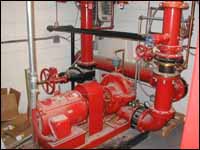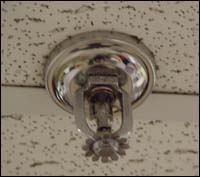Shipyard Employment eTool
Fire Protection >> Land-Side Fire Protection Systems
Land-side facilities that have automatic fire protection systems such as fire extinguishers, fixed systems, standpipes and automatic sprinkler systems must meet OSHA's standard requirements for employee safety. These systems present potential hazards that may cause an injury/illness to workers.
- Land-side fire protection systems
- Training. See Fire Protection: Training for specific requirements.
Additional Resources
- Fire Safety. OSHA Safety and Health Topics Page.

Potential Hazards
- Risk of employee injury/illness due to fire.
- Exposure to the extinguishing agents.
- Inadequate communication.
- Untrained employees trying to activate fire extinguishing system.
- System not maintained and tested.
- Using incorrect extinguishing agent.

Requirements and Example Solutions
- All fixed and portable fire protection systems (Figure 1) must meet OSHA standards for worker safety. [1915.507(a)]
- Portable fire extinguishers and hose systems must be selected, installed, inspected, maintained and tested to meet appropriate requirements (Figure 2). [1915.507(b), NFPA 10-2007 Standard for Portable Fire Extinguishers, NFPA 14-2007 Standard for the Installation of Stand Pipe, Private Hydrant, and Hose Systems]
- Fixed extinguishing system must: [1915.507(c), 1910.7]
- Ensure that all fixed extinguishing agents meet requirements for potential hazards and are approved by an OSHA National Recognized Testing Laboratory. [1915.507(c)(1)]
- Ensure that workers are safe when system is inactive. [1915.507(c)(2)]
- Ensure that repairs are done by a qualified technician or mechanic. [1915.507(c)(3)]
- Provide personal protective equipment where necessary. [1915.507(c)(4)]
- Post hazard warning and caution signs when extinguishing agent could be hazardous to workers safety or health (Figure 3). [1915.507(c)(5)]
- Select, install, inspect, maintain, and test all automatic fire detection systems and emergency alarms according to requirements. [1915.507(c)(6), 1915.5, NFPA 72-2007 National Fire Alarm Code]
-
All fixed extinguishing systems must be selected, installed, maintained, inspected, and tested in accordance with appropriate OSHA and NFPA requirements. Systems include: [1915.507(d)]

- Standpipe and hose systems. [1915.507(d)(1), NFPA 14-2007 Standard for the Installation of Stand Pipe, Private Hydrant, and Hose Systems]
- Automatic sprinkler systems (Figure 4). [1915.507(d)(2), NFPA 25-2002 Standard for the Inspection, Testing, and Maintenance of Water-Based Fire Protection Systems, NFPA 13-2007 Standard for the Installation of Sprinkler Systems, NFPA 750-2006 Standard on Water Mist Fire Protection Systems]
- Fixed extinguishing systems that use the following as the extinguishing agent:
- Water or foam. [1915.507(d)(3), NFPA 15-2007 Standard for Water Spray Fixed Systems for Fire Protection, NFPA 11-2005 Standard for Low-, Medium-, and High-Expansion Foam]
- Dry chemical. [1915.507(d)(4), NFPA 17-2002 Standard for Dry Chemical Extinguishing Systems]
- Gas. [1915.507(d)(5), NFPA 12-2005 Standard on Carbon Dioxide Extinguishing Systems, NFPA 12A-2004 Standard on Halon 1301 Fire Extinguishing Systems, NFPA 2001-2004 Standard on Clean Agent Fire Extinguishing Systems]

Additional Resource
- See Fire Protection Frequently Asked Questions (FAQs) A-4 for answers regarding use of the most current NFPA standards.
- Do not use fire safety vaults for storage.
- If maintenance and testing of system is contracted out, the contractor should coordinate with facility representative prior to performing the work.

